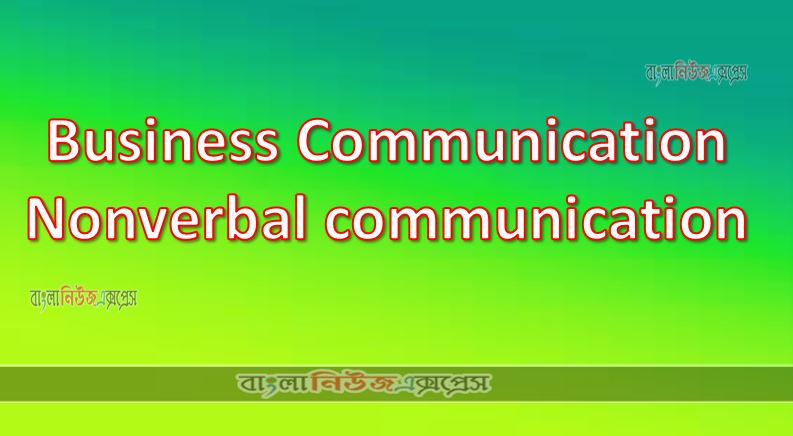Course Teacher :Syeda Sunjida Sultana
Business Communication
Chapter-5
Non verbal communication
Part-C
Broad Questions
Q: 1. What is visual Communication and discuss is purposes?
Q: 2. Discuss the types of visual communication.
Q: 1. What is visual Communication and discuss is purposes?
Answer :
Visual communication is the communication through visual aids. In other words, visual communication means the conveyance of ideas and information in forms that can be read or looked upon. It is simply the use of graphic tools which are visual means for sending and receiving messages.
Visual communication is the transmission of information and ideas using symbols and imagery. It is one of three main types of communication, along with verbal communication (speaking) and non-verbal communication (tone, body language, etc.). Visual communication is believed to be the type that people rely on most, and it includes signs, graphic designs, films, typography, and countless other examples.
Visual communication serves different purposes and is very essential and is very essential in business writing. The purposes served by visual correspondence are as follows-
- Readers expect to see graphics in documents.
- Visual communication is pleasant to the eyes.
- Graphics make long, monotonous text easy to read.
- Visual tools summarize a text.
- Graphics simplify and communication complex ideas and Data.
- Visual aids help readers find ideas easily.
- Charts and tables help to emphasize key ideas and concepts.
- Graphics concisely show Relationships.
- Readers are lass inclined to misinterpret information.
- Readers remember visual information more easily.
Q: 2. Discuss the types of visual communication.
Visual aids can broadly be divided into two types. - Tables
- Figures
- Tables: (সারণী) Table are parallel columns or rows of information that present data in cotegories to show changes in time , distance, cost , employment or some other distinguishable or quatifiable variable. Tables are used so thed readers can identify the numbers exactly.
- Figures : (পরিসংখ্যান) A Figures is any visual aid that is not a table, a categors that includes graphs, charts, drawings, diagrams, maps, icons.
a) Graphs: ( লেখচিত্র) A graphs is a diagram consisting of lines which display the variation of two quantities. graphs are used to show variations of temperature, production and sales, prices and profits etc. Bar and line graphs are the most frequently used graphs in business orignizations.
b) Charts: (তালিকা) A charts is used for displaying maps and graphs, for better visual effect.
c) Drawings: (অঙ্কন) Drawings can show wheara an object is located, low a tool or machine is put together or what siganals are given or steps taken ia a particular situnation.
d) Diagram: (চিত্র) A Diagram is a two-dimensional geometric sysbolic representation of information according to some visualization technique.
e) Photographs: (আলোকচিত্র) Their main advantage is they are great tools to explain points. For example in giving a talk about slums, pictures about the slums can give an accurate description of the slum life A photograph, if too small, will only serve as a distraction.
f) Maps : (মানচিত্র)In a geography speech, a map would be the most suitable item to use. A map can be used in showing different locations in the region and comparing them. This makes the audience know exactly where the speaker is referring to.
The advantage of using a map is it is simple to understand and can be used to make points of geographical reference. A map, for example, can be used to show the locations of all the hospitals in an area or the number of people with STIs in a certain region.
If a map has too much information on it, it may become cluttered therefore removing the focus of the audience from the message you wish to pass on. They will simply become distracted.
g) Icon: (প্রতিমুর্তি) A icon is a sign or representation that stands for its object by virtue of a resemblance of analogy to it.
- কোষ্ঠকাঠিন্য দূর করার উপায়, কোষ্ঠকাঠিন্য দূর করার সহজ উপায়
- LC কি, LC কয় প্রকার,LC বিস্তারিত আলোচনা কর
- অপূর্ণ তথ্যের নমুনা তত্ত্বটি সমালোচনাসহ আলোচনা কর।, সমালোচনাসহ অপূর্ণ তথ্যের নমুনা তত্ত্বটি বর্ণনা কর ।
- দীর্ঘমেয়াদি অর্থায়নের উৎসসমূহ আলোচনা কর,দীর্ঘমেয়াদি অর্থায়নের উৎস সম্পর্কে যা জান লিখ
- স্বল্পমেয়াদি অর্থায়নের জামানতযুক্ত ও জামানতবিহীন উৎসসমূহ লিখ






